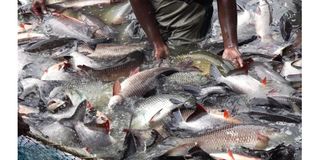Prime
Tanzanian innovator develops device to monitor feeding in fish farms

What you need to know:
- This automated fish feeder, known as the "autofeeder," provides farm owners with real-time information on the quantity and timing of feed given to the fish
Dar es Salaam. An innovator has developed a device to curb deception by fish farm supervisors.
This automated fish feeder, known as the "autofeeder," provides farm owners with real-time information on the quantity and timing of feed given to the fish.
To achieve abundant fish harvests, several tasks must be executed, including constructing a pond or enclosure, maintaining it, and caring for the fish using metallic structures, trees, and nets.
The device will directly send information to the owner via SMS, detailing the amount of food dispensed and the timing.
Mr Livinus Paschalates, the device developer from the University of Dodoma (UDOM), said at the 48th Dar es Salaam International Trade Fair grounds on July 1, 2024 that the device will reduce complaints from farmers about losses incurred due to fish deaths or failure to reach the required weight.
"This will eliminate the inconvenience of frequent farm visits to check on feeding details, thus enabling the owner to be away and still get the necessary information even from a distance," he said.
He also mentioned that this method will help reduce fish deaths caused by bacteria that thrive when fish handlers fail to use protective gear during feeding.
"From my small research, I have found that large-scale farmers have suffered losses due to feeding mistakes," said Mr Paschalates.
Aquaculture development expert Musa Said said the device will help control fish farm caretakers by facilitating timely feeding as scheduled on the calendar.
"Sometimes farm workers provide false information; for instance, they may claim to have fed the fish at 4 PM when they actually went to watch football. Or, they might be required to dispense 200 grammes but only provide 120 grammes over three months," Said explained.
He added that, while other testing methods may be consistent, subsequent reports could eventually indicate that the fish were not fed on time.
This highlights the need for such a device, which serves as the key link to ensuring optimal fish growth.
He emphasised that the device will contribute to the self-growth of fish and benefit farmers by providing accurate schedules from fish experts and specific feeding times.
However, he pointed out the challenges, including water capacity and the need for fry growers to consider the size of fry during planting, which is 20 grammes, so that by six months, on average, fish weigh between 250 and 300 grammes.





